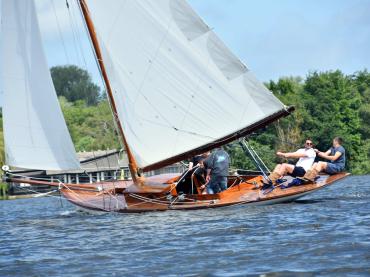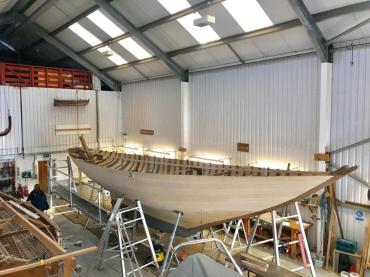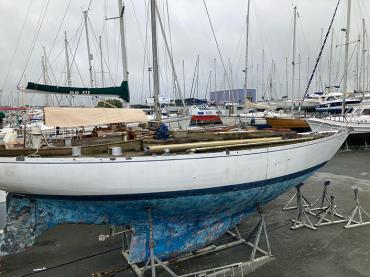Details
Construction
Dimensions
History
Mikado was designed and built at Fairlie by William Fife III in 1904 for Sir William Corry, as one of his two contributions to the new Clyde Linear 30 class of day racing cutters. The other Fife contribution was the almost identical Lilian, and the other four yachts in the 1904 fleet were all designed by Mylne. The fleet was vigorously raced round the various Clyde club regattas, and Mikado came second overall in the 1904 season, behind Mylne’s Armyne. The class rules for the Linear 30’s produced lightly built gaff cutters with a high ballast ratio. Even after weight gain over the years, 4 tons of Mikado’s total weight of 6.8 tons is lead keel. Above the keel, Mikado is constructed from Archangel Pine below waterline and Mahogany above, on oak frames with (originally) galvanised floors. The rig was the then typical gaff cutter, set on a pole mast with jackyard topsail and a short bowsprit. The deck layout was designed round two cockpits, with a hatch giving access to a stripped out interior. Class rules only required a bench seat on either side below. She probably had canvas covered decks. New additions to the Clyde 30 class in subsequent years made the original boats uncompetitive, and Mikado probably left the class as early as 1906. She probably stayed in Scotland till 1920, and by about 1924 she was re-rigged as a Bermudian cutter, still with bowsprit, and given a cruiser-racer accommodation below, with a large skylight in place of the original forward cockpit. The original design of the Clyde 30 class rules was intended to produce a yacht suitable for conversion to cruiser racing, since it was expected that design advances in a restricted rather than one-design class would otherwise make the useful life of the boats prohibitively short. Mikado may have spent some time in Ireland, before moving to the east Coast of England by the 1930’s where she was photographed racing with her present sail number 6. Beken of Cowes photographed her racing in the Channel Race in 1938, with the layout described above. Also in 1938 she was given a new mast made at Brightlingsea in Essex, which is still in use. She is reported as having been in the Medway in the 1950’s, Ireland in the 1960’s, and then Scotland again, but by 1990 she was found in a sorry state at Exeter, having acquired an unsightly plywood cabin structure designed to provide standing headroom inside. From 1990 to 1994 Mikado was given a thorough restoration by Chris Cracknell at his farm near Wimborne Minster in Dorset. Most of the original planking and framing was preserved, together with some of the original fastenings, as well as the keel and mast, but she was given new stainless steel floors, mast step and straps, a new planked deck on a plywood sub-deck, new coachroof, cockpit and traditional metal fittings. She was also fitted out with a simple two berth oak-panelled interior, together with a light weight 16 hp Dolphin petrol engine driving a wing mounted propeller. Appearance on deck is completely traditional, and Chris Cracknell went to the enormous trouble of fabricating most of the metal deck fittings himself, including all rigging screws, and sourcing traditional sheet and halyard winches from the Antipodes. Pulpits, guardrails and all other modern deck fittings are studiously avoided. The concept behind the restoration was to re-create her cruiser-racer appearance of 1924, using traditional materials, but with certain ‘improvements’ consistent with what Fife might have done then, had he been given the task. He did in fact produce a bermudian sloop rig drawing for her sister Lilian, then called Sunshine, in 1924, but it was not followed. Thus she now has a low coachroof rather like that of Fife’s own Clio (which he designed as the prototype of a new Clyde cruiser racer class in the early 1920’s) and a powerful masthead cutter rig very like that of Fife’s Madrigal, with no bowsprit and a shorter boom allowing for a fixed backstay as well as runners, altogether a much safer rig for shorthanded sailing. Nonetheless because (unlike her 1907 class sister Corrie), her mast was never moved aft, she retains a very long boom by modern standards, and therefore a more traditional lower aspect ratio rig than on most bermudian conversions. Her panelled interior, while completely traditional, is probably better than what she was given in the 1920’s, and although giving less than 6 ft headroom, makes for elegant if not spacious living for 2, with a third berth in the focsle. Modern electronic navigation gear is kept to a discreet minimum, but there is at least a proper loo compartment behind panelled doors. Southern Sails provided a traditional looking narrow panelled suit of cream Dacron sails, and an enormous masthead spinnaker. Working sail area is just under 1,000 square feet, and the spinnaker just over that. The working sails are now being replaced by White Sails of Warsash, and she also sports an assymetric spinnaker. The main has traditional roller reefing, on a boom which, by being of larger diameter at the clue, raises rather than lowers the clue as you reef, keeping the sail above the sea as it gets rougher. The result is a very fast cruiser racer, giving by modern standards a wet (and therefore exciting) ride, easily sailed by two, quite easily single-handed, and using an ideal race round the cans crew of five or six. She competes on almost precisely level terms with the only other Clyde 30 survivor in the UK, namely Corrie (also Fife designed in 1908, but built by Robertsons of Sandbanks), even though Corrie is two feet longer, with a taller mast. She also competes with modern cruiser racers in light to moderate weather, demonstrated by coming second in her ISC class at Cowes Week in 2002 using a handicap system without any age allowance. 2003 saw her pitted against her traditional sisters, first at the Fife Centenary regatta in the Clyde, and later in the Prada series in the Mediterranean, with the British Classic Yacht Club regatta and Cowes Week in between. She came second in class 1 on the Clyde, behind The Lady Anne (Fife 15 metre), first equal at the BCYC regatta with Arrow, second in IRC class 7 at Cowes Week, third in her class at Monaco, and second in the entire Prada fleet on the passage race from Cannes to St Tropez. In 2004 she competed in the Chichester Cruiser Racer series, and won the Spring series, and several other trophies. She joined by invitation (and won) the RYS cruiser rally, and won the racing yacht class in the BCYC regatta, scoring the highest points in the whole fleet and winning the round the island BCYC race. She came second in IRC class 7 at Cowes week (to Whooper). She celebrated her centenary on 17th July with a large party at Northney marina. 2005 saw a similar performance to 2004. She won the Spring and Summer series in the CCRC IRC rated class, came second in the classic racing yacht class in the main Round the Island Race, second (again! But to a different winner) in IRC class 7 at Cowes Week. She now sports a battened blade jib as part of a slutter rig in stronger winds, managing despite low freeboard to maintain full main up to force 5. Mikado has been by far the oldest boat in 4 years’ competition at Cowes Week, and it is fair to say has established herself as fully competitive with modern racing yachts under IRC. She is the oldest yacht in modern racing in the UK.
Own this vessel?
If you are the owner of this vessel and would like to provide more details or updated information, please contact info@nationalhistoricships.org.uk










